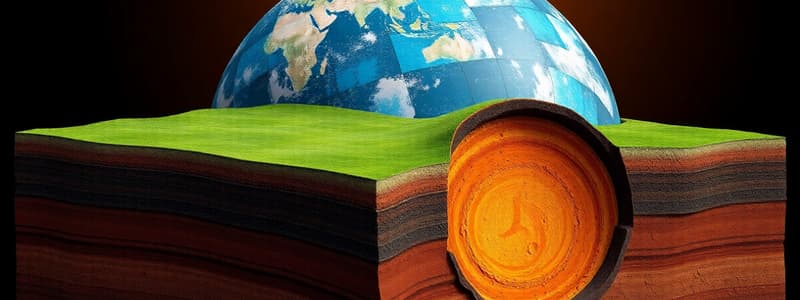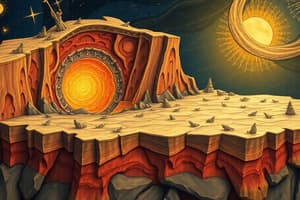Podcast
Questions and Answers
What is the primary material composition of oceanic crust?
What is the primary material composition of oceanic crust?
- Basalt (correct)
- Sedimentary rock
- Granite
- Limestone
How thick is the continental crust on average?
How thick is the continental crust on average?
- 3 to 5 miles
- 25 miles (correct)
- 12 to 15 miles
- 50 miles
Which layer of the Earth constitutes about 82% of its volume?
Which layer of the Earth constitutes about 82% of its volume?
- Crust
- Inner core
- Mantle (correct)
- Outer core
Which process involves heat transfer through the movement of materials?
Which process involves heat transfer through the movement of materials?
What percentage of the Earth's core is made up of iron?
What percentage of the Earth's core is made up of iron?
What primarily composes oceanic plates?
What primarily composes oceanic plates?
Which boundary type involves plates sliding past each other?
Which boundary type involves plates sliding past each other?
What is the average thickness of tectonic plates in the lithosphere?
What is the average thickness of tectonic plates in the lithosphere?
What is created when plates at a divergent boundary move apart?
What is created when plates at a divergent boundary move apart?
How many major tectonic plates are recognized?
How many major tectonic plates are recognized?
What primarily drives the movement of tectonic plates?
What primarily drives the movement of tectonic plates?
Which of the following actions is considered a constructive process?
Which of the following actions is considered a constructive process?
At convergent boundaries, what typically forms when one plate moves under another?
At convergent boundaries, what typically forms when one plate moves under another?
What is the primary process described by denudation?
What is the primary process described by denudation?
Which type of weathering primarily occurs due to temperature variations?
Which type of weathering primarily occurs due to temperature variations?
What causes spheroidal weathering?
What causes spheroidal weathering?
What is exfoliation weathering also known as?
What is exfoliation weathering also known as?
Which condition is NOT primarily associated with physical weathering?
Which condition is NOT primarily associated with physical weathering?
How does thermal stress weathering contribute to both physical and chemical weathering?
How does thermal stress weathering contribute to both physical and chemical weathering?
What is the main effect of freeze-thaw weathering on rocks?
What is the main effect of freeze-thaw weathering on rocks?
Which of the following best describes the process of decomposition?
Which of the following best describes the process of decomposition?
What is the primary effect of roots burrowing into rocks?
What is the primary effect of roots burrowing into rocks?
What defines the process of deflation in the context of wind erosion?
What defines the process of deflation in the context of wind erosion?
Which type of sand dune has a steep side that faces away from the wind?
Which type of sand dune has a steep side that faces away from the wind?
What is the main characteristic of suspended load in wind transportation?
What is the main characteristic of suspended load in wind transportation?
What causes coastal erosion along shorelines?
What causes coastal erosion along shorelines?
Which of the following best describes longitudinal dunes?
Which of the following best describes longitudinal dunes?
What is hydraulic action in the context of coastal erosion?
What is hydraulic action in the context of coastal erosion?
What is a defining characteristic of bed load in wind transportation?
What is a defining characteristic of bed load in wind transportation?
What characterizes an aquifuge?
What characterizes an aquifuge?
What is the main cause of earthquakes?
What is the main cause of earthquakes?
What does the term 'epicenter' refer to in seismology?
What does the term 'epicenter' refer to in seismology?
Which fault type occurs when the crust is being pulled apart?
Which fault type occurs when the crust is being pulled apart?
What does the Richter Magnitude Scale measure?
What does the Richter Magnitude Scale measure?
What distinguishes sinistral strike slip from dextral strike slip?
What distinguishes sinistral strike slip from dextral strike slip?
Which of the following best describes the focus of an earthquake?
Which of the following best describes the focus of an earthquake?
What scale measures the intensity of earthquakes based on observed effects?
What scale measures the intensity of earthquakes based on observed effects?
Flashcards are hidden until you start studying
Study Notes
Earth Structure
- The Earth’s structure comprises various spherical layers, categorized by chemical/elemental composition and mechanical/physical properties.
Compositional (Chemical) Layers of Earth
- Layers are defined based on their chemical or elemental makeup.
Crust
- Composed of elements like oxygen, silicon, aluminum, iron, calcium, sodium, potassium and magnesium
- 3 to 5 miles thick under the ocean, 25 miles thick under continents.
Types of Crust
- Oceanic Crust (Basaltic)
- Formed from magma that erupts on the seafloor creating basalt lava flows or cools deeper to form igneous rock gabbro.
- Covered by sediments, thicker near the shore.
- Continental Crust (Granitic)
- Made up of various types of rocks.
- Average composition is granite, less dense than oceanic crust.
- Thicker part of the crust.
Mantle
- Layer beneath the crust, comprises 82% of the Earth’s volume.
- About 1,800 miles deep.
- Mostly made of silicate rocks rich in magnesium and iron.
- Heat causes rocks to rise.
Conduction
- Heat transfer through rapid collisions of atoms, happening in solids.
- Heat flows from warmer to cooler areas until they reach the same temperature.
Convection
- Process of material capable of movement and flow that develops convection currents.
Core
- The Earth's center, made of 85% iron metal and 15% nickel.
Plate Tectonics
- Scientific theory explaining the large-scale motion of seven major plates and numerous smaller plates.
- Began 3.3 to 3.5 billion years ago.
- Average tectonic plate thickness in the lithosphere is about 100 km.
7 Major Tectonic Plates:
- Pacific Plate (103,300,000 sq km)
- North American Plate (75,900,000 sq km)
- Eurasian Plate (67,800,000 sq km)
- African Plate (61,300,000 sq km)
- Antarctic Plate (60,900,000 sq km)
- Indo-Australian Plate (58,900,000 sq km)
- South American Plate (43,600,000 sq km)
Types of Tectonic Plates:
- Oceanic Plates: Composed of oceanic crust, mostly magnesium and silicon minerals.
- Continental Plates: Composed of continental crust, mainly aluminum and silicon materials.
Boundaries of Tectonic Plates
- Transform Boundary: Plates move past each other by sliding. Minimal damage occurs. Called faults.
- Divergent Boundary: Plates slide apart, moving in opposite directions. Often occurs in seafloors, creating new ocean floor. Volcanic activity produces mid-ocean ridges and small earthquakes.
- Convergent Boundary: Plates move against each other, one plate going underneath the other. Volcanoes and mountains are formed at these boundaries.
Movement of Tectonic Plates
- Mantle convection drives plate tectonics:
- Hot mantle rises at the ridge axis, creating new ocean crust.
- Top of the convection cell moves horizontally away from the ridge crest as does the new seafloor.
- Outer limbs of the convection cells plunge into deeper mantle, dragging oceanic crust at deep-sea trenches.
- Material sinks to the core and moves horizontally.
- Material heats up and rises again.
Landforms and Earth Processes
- Dynamic actions within or on the Earth's surface.
- Constructive Processes: Build up earth material or landforms (e.g., erosion, transportation of sediments).
- Destructive Processes: Break down Earth material or destroy landforms (e.g., decomposition).
- Decomposition: Process of breaking down mineral constituents to form new components due to chemical action of physical agents.
- Denudation: Earth’s surface is worn away by chemical and mechanical actions of physical agents, exposing lower layers.
Processes of Weathering
- Physical Weathering: Physical breakdown of rock masses under the attack of atmospheric agents.
- Rocks are broken into smaller irregular fragments and particles.
- Most active in cold, dry, and higher areas.
- Caused by temperature variations.
- Exfoliation: Curved plates of rock are stripped (onion-skin weathering).
- Forms dome-shaped hills or dome rocks.
- Occurs along planes of parting called joints.
- Caused by unequal expansion and contraction due to temperature variations.
- Freeze-Thaw Weathering: Water enters rock cracks, freezes, expands, and melts, repeating until the rock splits.
- Chemical Weathering: Chemical decomposition of rock, altering mineral structure by adding or removing elements through chemical reactions between the atmosphere and rocks.
- Occurs with water dissolving active gases from the atmosphere.
- Spheroidal Weathering: Chemical weathering caused by water penetration at joints/fractures, attacking from all sides. Concentric or spherical shells of decayed rock are loosened and separated.
Earth Process by Wind
- Erosion: Wearing away of rock along the coastline caused by destructive waves.
- Deflation: Wind removing loose material from flat, dry areas (deserts, dry lake beds, floodplains, glacial washout plains).
- Abrasion: Scraping of rock surfaces by friction between rocks and moving particles.
- Transportation: Wind carries sediments:
- Bed Load: Larger and heavier particles moved by wind, not lifted higher than 30-60 cm above the surface.
- Suspended Load: Finer particles lifted by wind hundreds of meters above the surface.
- Deposition: Wind-blown sediments are dropped and deposited forming Aeolian deposits.
- Sand Dunes: Huge heaps of sand formed by wind deposition in recognizable shapes.
- Barchans (Crescent-Shape Dunes): Triangular in section.
- Steep side faces the wind.
- Gentle side lies on the windward side.
- Transverse Dunes: Similar to Barchans, but longer axis lies transverse to the prevailing wind direction.
- Longitudinal Dunes: Elongated sand ridges with the longer axis parallel to the prevailing wind direction.
- Aquifuge: Neither porous nor permeable geological formation. No interconnected openings. Cannot transmit or absorb water. Suitable for groundwater occurrence.
Earthquake
- Sudden shaking of the ground caused by seismic waves passing through the Earth's rocks, most often along geologic faults.
- Release of sudden and extreme energy caused by shifting in the Earth's crust.
Seismology
- The study of earthquakes and seismic waves.
Faults
- Narrow zones where rock masses move in relation to each other.
- A planar or gently curved fracture in the Earth's crust, where compression or tensional forces cause relative displacement of rocks on opposite sides.
Classification of Faults:
- Normal Slip Fault: Crust is pulled apart. The hanging-wall block moves down relative to the footwall block.
- Reverse Slip Fault: Crust is compressed. The hanging-wall block moves up and over the footwall block.
- Strike Slip Fault: Crustal blocks move sideways past each other, usually along nearly-vertical faults.
- Sinistral Strike Slip: Far side moves to the left.
- Dextral Strike Slip: Far side moves to the right.
Earthquake Terminology:
- Focus: The exact spot beneath the Earth's surface where an earthquake originates.
- Epicenter: Point on the Earth's surface directly above the earthquake's focus.
- Intensity: Severity of earthquake shaking, based on its effects on people, the environment, and the Earth's surface. Determined by total energy released.
- Magnitude: Quantitative measure of the earthquake's size at its source. Based on total energy released.
- Modified Mercalli Intensity Scale: Measures earthquake intensity based on observational effects.
- Richter Magnitude Scale: Measures earthquake energy released using a seismograph, assigns values between 1 and 10.
Studying That Suits You
Use AI to generate personalized quizzes and flashcards to suit your learning preferences.




